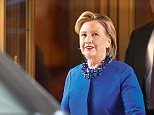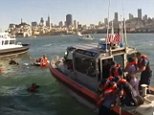Stop the King taking off! It's the dramatic untold twist of the abdication crisis: how Edward VIII tried to flee the country in his private plane - and sent the Government into a tailspin
- In December 1936 Edward announced plans to wed Wallis Simpson
- He planned to slip out of Britain, plunging it into a new constitutional crisis
- The King confided to one of his friends - backbench MP Winston Churchill
- From the book, The King Who Had To Go: Edward VIII, Mrs Simpson And The Hidden Politics Of The Abdication Crisis, published October 13

King Edward VIII in his flying helmet in 1927
Neville Chamberlain, the Chancellor of the Exchequer, came on the line, his voice agitated: ‘Zurich. Aeroplanes ready.’ He could hardly get the words out.
Tommy Dugdale, parliamentary private secretary to Prime Minister Stanley Baldwin, was at Fort Belvedere, the King’s private home in Windsor Great Park, as the final preparations for the abdication were being made.
He was bemused to hear Chamberlain, usually suave and calm, so stressed.
When the Chancellor finally made sense, Dugdale was in no doubt of the seriousness of the message.
Two aircraft, one precious cargo – King Edward VIII. Destination Zurich. The result – a destabilised country and Britain in its biggest royal mess since 1688 when James II fled to France in the face of a parliamentary coup.
Those flights had to be stopped.
It was December 1936 and since Edward had announced his plans to wed twice-married Wallis Simpson, the Government had blocked his every wish – including his plan to make a broadcast to the Empire ‘to tell them that he intended to marry Mrs S but without announcing his abdication’.
And they had refused to countenance the compromise of a morganatic marriage in which she would not have become Queen.
With his options running out, the King was braced to accept that abdication was inevitable, provided – and it was a big condition – Mrs Simpson could be guaranteed that her divorce would go through so that she and the King could marry.
Scroll down for video

Escape plan: The King's personal plane. He planned to slip out of Britain, plunging it into a new constitutional crisis
But he had one more shock in store. Before agreeing to any terms, he planned to slip out of Britain, plunging it into a new constitutional crisis.
The King had confided the scheme to one of his few remaining friends, Winston Churchill, who immediately recognised its danger. Churchill, then a backbench MP in his ‘wilderness years’, supported the King in general, but saw that such a move would be disastrous.
In a letter to His Majesty, he even warned: ‘On no account must the King leave the country.’
But the King’s plans were well advanced. Arrangements for flights to the Alps with his luggage and entourage on board had been made. Rooms were booked at the Dolder Grand Hotel just outside Zurich, and a letter of credit for £5,000 (equivalent to £250,000 today) was obtained from Coutts Bank.
The King did not know the Dolder. It stood on a hilltop, but its grounds were relatively small, offering no protection from the press pack outside.
Nor would the King have been the only guest. A stay there would have been anything but the oasis of tranquillity and seclusion for which he yearned. But the Dolder was the place on which he had set his heart.

The Duke of Windsor - formerly King Edward VIII - meeting the Duchess, Wallis Simpson

Edward in 1957: How different history might have been had that last order not come down to halt the capricious King’s desires to flee the country and become Britain’s monarch in exile

The King had confided the scheme to one of his few remaining friends, Winston Churchill (pictured), who immediately recognised its danger
How the King would get to Switzerland presented no major difficulties. As Prince of Wales, Edward had learned to fly, and he had bought the first aeroplanes for the Royal Household, which he used routinely.
He had also taken on a reserve officer of the RAF, Edward ‘Mouse’ Fielden, as his personal pilot. By 1936, the King had acquired a de Havilland Dragon Rapide as his personal aircraft with the registration G-ADDD. It was based at Hendon aerodrome and could have managed the trip to Zurich comfortably in a day.
Frustrated that Baldwin killed off the idea of a broadcast, the King craved escape from Fort Belvedere and the trap he had created for himself. Over dinner the previous evening, he told Churchill that he wanted a fortnight to weigh up the matter. If he could go to Switzerland with a couple of equerries, he would be able to mull his decision without undue pressure.
Churchill’s view that the King should not be allowed to leave suggests he did not see the plan as merely a holiday. Leaving the country also had the flavour of deserting a battle station. As usual with unwelcome advice, the King made no response and passed on to other matters. His mind was made up.
When the King saw Baldwin the following day to discuss the plan for two parliamentary Bills – one to effect the abdication and the other to grant Mrs Simpson an immediate divorce – he did not ask him about the idea of leaving the country.
But this did not mean the idea was dead. The King simply went ahead with the preparations in secrecy. That afternoon, Fielden was instructed to be ready to leave for Zurich at 9.30 the following morning.

The Duchess of Windsor pictured arriving at London Airport escorted by Earl Mountbatten

Edward VIII and Wallis Simpson pictured together leaving Claridge's Hotel in London
An extra aircraft had also been arranged to transport the luggage of the King and his entourage, to leave at the same time.
This meant the King would leave for Zurich before the Government had a chance to even consider the ‘Two Bills’ scheme, let alone implement it. Thus the stage was set for a fantastically irresponsible and cavalier act: Edward VIII would imitate James II and simply flee the country with nothing settled.
The King and the country escaped the consequences of this folly only because of a combination of Fielden’s sense of discipline and the Government’s intelligence operations.

Wallis Simpson at London Airport in 1972
Some time on the Saturday, Fielden sought Air Ministry approval for leaving the country. It was supposedly a normal application, but the way in which it was handled was far from routine.
The request was passed up the hierarchy of the Ministry until it reached the Air Minister himself, Lord Swinton. Presumably the lower ranks had been put on alert to apply special treatment to such a request.
There was good reason for the authorities to be on their guard.
The Government had been alerted to the likelihood that the King would fly to Zurich by cables between journalists who had got wind of the story, which had been passed on by Cable & Wireless Ltd. The company had previously betrayed Mrs Simpson’s tip-offs to the press in America about her romance.
The supposedly private business, responsible for Britain’s international cable traffic, was secretly controlled by the Government, and operated as an arm of the State.
At the same time, Fielden must have recognised the implications of the proposed flight and made a point of ensuring it received consideration higher up the chain of command. Fielden had been placed in a difficult position by the King’s orders, and few would blame him for breaching confidence.

Since Edward had announced his plans to wed twice-married Wallis Simpson (pictured together), the Government had blocked his every wish
In turn, Swinton alerted Neville Chamberlain, who spotted major trouble brewing and went to No 10, but the Prime Minister was absent at Fort Belvedere. With mounting anxiety, he phoned Tommy Dugdale there. Once he understood the seriousness of the situation, Dugdale sought out Ulick Alexander, the King’s personal steward, to tell him to stand the planes down.
While Chamberlain waited to hear back from Dugdale, the team began to prepare for the worst. Sir Horace Wilson, Baldwin’s closest civil service adviser, judged that things might move so fast that drastic action could be required. He told the lawyers to get an Instrument of Abdication ready for the King’s signature.
Had the King persisted with the plan of flying to Zurich, this would have meant that he could be confronted by Government agents at Hendon aerodrome and told that he would have to abdicate before he was allowed on the plane.
It is a moot point as to whether Sir Horace saw this as a satisfactory conclusion to the crisis or, as it would almost certainly have appeared, a humiliating and shameful combination of Royal caprice and Government ruthlessness.
Fortunately for everyone, Dugdale was able to defuse the situation.
‘You fellows are pretty cool, and what about these aeroplanes at Hendon?’ he said when he finally confronted Ulick Alexander.
‘How did you know about them?’ asked Alexander, surprised.
‘Will you go and cancel them now?’
‘I can’t do that. They are under the King’s orders,’ said Alexander.
‘Never mind that, it must be done.’
And it was done. The moment of greatest danger had passed, but Sir Horace was not going to let the opportunity slip to ratchet up the measures that he thought necessary to keep a check on the King.

The King (pictured with Wallis Simpson in 1937), was braced to accept that abdication was inevitable provided Mrs Simpson could be guaranteed that her divorce would go through
That morning, he had already tried to persuade Chamberlain and Home Secretary Sir John Simon that the King’s telephones should be tapped, as he later put it with breathtaking hypocrisy, ‘in the interests of the King as head of State’.
The phone lines between Buckingham Palace and Fort Belvedere and the Villa Lou Viei – the villa in Cannes where Mrs Simpson was staying – were indeed tapped.
Despite such drastic measures, Downing Street’s intelligence was wrong on one point. They had jumped to the conclusion that the King intended to use the aeroplanes to join Mrs Simpson at Cannes, not part of a covert escape plan to Switzerland.
Dugdale did not know exactly what he was stopping – but he knew that for the sake of the country, it must be stopped.
How different history might have been had that last order not come down to halt the capricious King’s desires to flee the country and become, however briefly, Britain’s monarch in exile.
© Adrian Phillips, 2016
Taken from The King Who Had To Go: Edward VIII, Mrs Simpson And The Hidden Politics Of The Abdication Crisis, published by Biteback on October 13, priced £25. To order a copy for £18.75 with free p&p, visit www.mailbookshop.co.uk or call 0844 571 0640 by October 16.
Most watched News videos
-
 CCTV captures final tragic moments of Mirna Salihin's life
CCTV captures final tragic moments of Mirna Salihin's life -
 Mother shaves daughters hair after she 'bullies cancer girl'
Mother shaves daughters hair after she 'bullies cancer girl' -
 GRAPHIC CONTENT: 'Ghost' rises from body after fatal crash
GRAPHIC CONTENT: 'Ghost' rises from body after fatal crash -
 Bulls head butt each other then die instantly from brutal blow
Bulls head butt each other then die instantly from brutal blow -
 Shocking moment girl gets viciously beaten after starting fight
Shocking moment girl gets viciously beaten after starting fight -
 Mother releases devastating footage of son's final moments
Mother releases devastating footage of son's final moments -
 Lorry smashes into car leaving driver with severe injuries
Lorry smashes into car leaving driver with severe injuries -
 Is this the creepy moment the corpse of a girl OPENS her eyes?
Is this the creepy moment the corpse of a girl OPENS her eyes? -
 'Big fat gypsy wedding' in Romania goes on for FOUR days
'Big fat gypsy wedding' in Romania goes on for FOUR days -
 Groom ALREADY tired of marriage life just after 15 minutes
Groom ALREADY tired of marriage life just after 15 minutes -
 'Pascal's a G!' Kim Kardashian speaks well of her bodyguard
'Pascal's a G!' Kim Kardashian speaks well of her bodyguard -
 GoPro captures the moment a croc swims amongst swimmers
GoPro captures the moment a croc swims amongst swimmers
-
 Trump is CHEERED outside Trump Tower: Defiant Donald greets...
Trump is CHEERED outside Trump Tower: Defiant Donald greets...
-
 Trump called his daughter Ivanka 'a voluptuous piece of...
Trump called his daughter Ivanka 'a voluptuous piece of...
-
 Donald Trump called his pregnant wife Melania 'a monster'...
Donald Trump called his pregnant wife Melania 'a monster'...
-
 Gang member suspected of killing two Palm Springs police...
Gang member suspected of killing two Palm Springs police...
-
 Julian Assange warns WikiLeaks will expose Google as he...
Julian Assange warns WikiLeaks will expose Google as he...
-
 Tat looks painful! Tattoo fans from around the world flock...
Tat looks painful! Tattoo fans from around the world flock...
-
 Nancy O'Dell says she's 'saddened' by Donald Trump's...
Nancy O'Dell says she's 'saddened' by Donald Trump's...
-
 Matthew marches on: Hurricane strikes North Carolina dumping...
Matthew marches on: Hurricane strikes North Carolina dumping...
-
 'A sad day for all women, minus one': SNL skit shows Hillary...
'A sad day for all women, minus one': SNL skit shows Hillary...
-
 Is Pence planning to drop out of the race? Rumors Indiana...
Is Pence planning to drop out of the race? Rumors Indiana...
-
 Streets running with blood and 3,700 dead: After 100 days in...
Streets running with blood and 3,700 dead: After 100 days in...
-
 Rape victim wiped her own blood on her teen attacker and...
Rape victim wiped her own blood on her teen attacker and...






















































































































































































































































